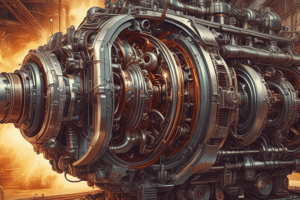Podcast
Questions and Answers
What is the primary purpose of classifying engines by application?
What is the primary purpose of classifying engines by application?
- To identify the type of industrial equipment used
- To specify the engine's purpose and intended use (correct)
- To determine the number of cylinders required
- To calculate the engine's power output
What is the main factor that determines the number of cylinders in an engine?
What is the main factor that determines the number of cylinders in an engine?
- The engine's power requirements (correct)
- The engine's arrangement of cylinders
- The type of industrial equipment used
- The engine's displacement
What is the common unit of measurement used to classify engines by displacement?
What is the common unit of measurement used to classify engines by displacement?
- Cubic inches
- Cubic centimetres
- Litres
- All of the above (correct)
What is the characteristic of a 'V' type engine?
What is the characteristic of a 'V' type engine?
Which type of engine classification is based on the engine's physical characteristics?
Which type of engine classification is based on the engine's physical characteristics?
What is the purpose of Figure 11?
What is the purpose of Figure 11?
What is the primary purpose of an intercooler or aftercooler in a supercharged engine?
What is the primary purpose of an intercooler or aftercooler in a supercharged engine?
What is the main difference between a naturally aspirated engine and a supercharged engine?
What is the main difference between a naturally aspirated engine and a supercharged engine?
What is the purpose of a heat exchanger in a liquid-cooled engine?
What is the purpose of a heat exchanger in a liquid-cooled engine?
What is the characteristic of a dual fuel engine?
What is the characteristic of a dual fuel engine?
What is the classification of an engine that operates at a speed of 2200 rpm?
What is the classification of an engine that operates at a speed of 2200 rpm?
What is a common unit of measurement for engine power rating?
What is a common unit of measurement for engine power rating?
Flashcards are hidden until you start studying
Study Notes
Engine Classification
- Classifying engines by application helps in understanding the intended use, such as automotive, industrial, or aerospace, facilitating better design and performance optimization.
Engine Cylinders
- The number of cylinders in an engine is primarily determined by the desired power output and efficiency; more cylinders generally provide higher power and smoother operation.
Engine Displacement Measurement
- Engines are commonly classified by displacement measured in liters (L) or cubic centimeters (cc), indicating the total volume of all cylinders.
'V' Type Engine Characteristics
- A 'V' type engine has cylinders arranged in a V configuration, promoting compact design and often allowing for more cylinders in a smaller engine space.
Physical Characteristics Classification
- Engine classification based on physical characteristics includes categories like inline, V-type, or flat designs, depending on the arrangement of cylinders.
Role of Figure 11
- Figure 11 serves as a visual reference to illustrate key engine components or principles, aiding in comprehension of complex concepts.
Purpose of Intercooler or Aftercooler
- The intercooler or aftercooler in a supercharged engine reduces the temperature of the compressed air, enhancing performance and increasing engine efficiency by preventing knocking.
Naturally Aspirated vs. Supercharged Engine
- A naturally aspirated engine relies on atmospheric pressure for air intake, while a supercharged engine uses a compressor to force more air into the cylinders, boosting power.
Heat Exchanger in Liquid-Cooled Engines
- The heat exchanger in a liquid-cooled engine dissipates excess heat from the coolant, maintaining optimal operating temperatures and preventing overheating.
Dual Fuel Engine Characteristics
- A dual fuel engine can operate on two different types of fuel, typically allowing for more flexibility and efficiency depending on fuel availability and cost.
Engine Speed Classification
- An engine operating at a speed of 2200 rpm falls into the category of moderate-speed engines, often used in applications requiring balance between power and efficiency.
Engine Power Rating Measurement
- Engine power ratings are commonly measured in horsepower (hp) or kilowatts (kW), quantifying the engine's capability to perform work.
Studying That Suits You
Use AI to generate personalized quizzes and flashcards to suit your learning preferences.




